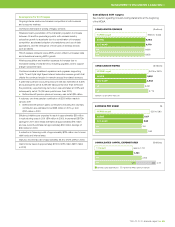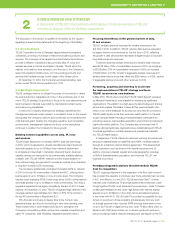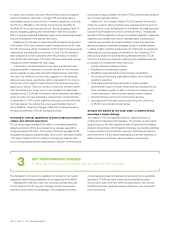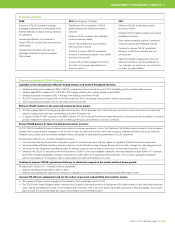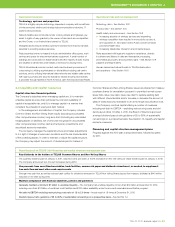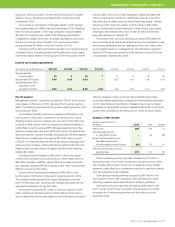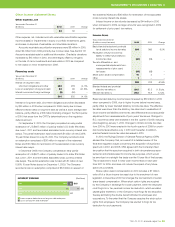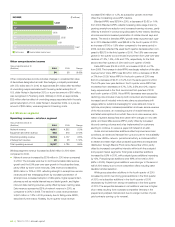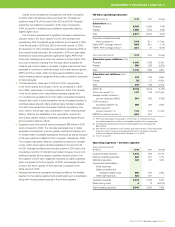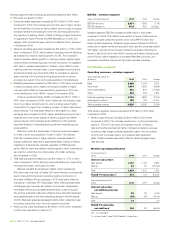Telus 2010 Annual Report Download - page 58
Download and view the complete annual report
Please find page 58 of the 2010 Telus annual report below. You can navigate through the pages in the report by either clicking on the pages listed below, or by using the keyword search tool below to find specific information within the annual report.
54 . TELUS 2010 annual report
Reporting back on TELUS’ 2010 financing and capital structure management plan
Maintain position of fully hedging foreign exchange exposure for indebtedness
Maintained for the 8% U.S. dollar Notes due June 2011, the only foreign currency-denominated debt issue. The Company unwound the portion of its
cross currency interest rate swaps associated with the early partial redemption of 45% of these Notes outstanding at September 2, 2010 (see Section 7.3
Cash used by financing activities).
Preserve access to the capital markets at a reasonable cost by maintaining investment grade credit ratings in the range of BBB+
to A–, or the equivalent, in the future
At February 24, 2011, investment grade credit ratings from the four rating agencies that cover TELUS were in the desired range with a stable trend or outlook.
from the open market with no discount. Non-Voting Shares acquired
with optional cash payments at 100% of the average price under
the DRISP program will also change from treasury issuance to market
purchase, which will come into effect on March 1, 2011. The change
will result in increased cash outlays in respect of dividend payments.
While anticipated cash flow is expected to be more than sufficient
to meet current requirements and remain in compliance with TELUS’
financial policies, these intentions could constrain TELUS’ ability to invest
in its operations for future growth. As described in Section 1.5, payment
of net cash income taxes and funding of defined benefit pension plans
will reduce the after-tax cash flow otherwise available to return capital to
the Company’s shareholders. If actual results are different from TELUS’
expectations, there can be no assurance that TELUS will not need to
change its financing plans, or its intention to pay dividends according
to the target payout guideline. For the related risk discussion, see
Section 10.6 Financing and debt requirements.
4.4 Disclosure controls and procedures
and internal control over financial reporting
Disclosure controls and procedures
Disclosure controls and procedures are designed to provide reasonable
assurance that all relevant information is gathered and reported to senior
management, including the President and Chief Executive Officer (CEO)
and the Executive Vice-President and Chief Financial Officer (CFO),
on a timely basis so that appropriate decisions can be made regarding
public disclosure.
The CEO and the CFO have evaluated the effectiveness of the
Company’s disclosure controls and procedures related to the preparation
of the MD&A and the Consolidated financial statements. They have
concluded that the Company’s disclosure controls and procedures were
effective, at a reasonable assurance level, to ensure that material infor-
mation relating to the Company and its consolidated subsidiaries would
be made known to them by others within those entities, particularly
during the period in which the MD&A and the Consolidated financial
statements contained in this report were being prepared.
Internal control over financial reporting
Internal control over financial reporting is designed to provide reasonable
assurance regarding the reliability of financial reporting and the prepara-
tion of financial statements in accordance with Canadian GAAP and the
requirements of the Securities and Exchange Commission in the United
States, as applicable. TELUS’ CEO and CFO have assessed the effective-
ness of the Company’s internal control over financial reporting as at
December 31, 2010, in accordance with Internal Control – Integrated
TELUS’ 2011 financing and capital structure
management plan
At December 31, 2010, TELUS had access to undrawn credit facilities
of more than $1.8 billion and availability of $100 million under its accounts
receivable securitization program. At December 31, 2010, the Company
had access to a shelf prospectus pursuant to which it can issue up
to $2 billion of debt and equity. TELUS believes that its investment grade
credit ratings provide reasonable access to capital markets to facilitate
future debt issuance.
The Company’s long-term debt principal maturities are illustrated
in the adjacent chart, including maturity of its 8% U.S. dollar Notes in
June 2011. TELUS expects to maintain its current position of fully hedging
its foreign exchange exposure for indebtedness on the U.S. dollar debt.
TELUS may issue additional long-term debt to refinance the 8% U.S. dol-
lar Notes, although the Company has sufficient unutilized credit facilities
to refinance this debt without accessing the long-term debt markets.
At the end of 2010, 93% of TELUS’ total debt was on a fixed-rate
basis and the weighted average term to maturity was approximately
5.7 years, up from 5.0 years at the end of 2009.
LONG-TERM DEBT PRINCIPAL MATURITIES
AS AT DECEMBER 31, 2010 ($ millions)
Maturities in 2011 include the derivative liability associated with U.S. dollar Notes,
at exchange rates in effect on December 31, 2010.
1,142
700
625
404
300
2025
2024
2023
2022
2021
2020
2019
2018
2017
2016
2015
2013
2014
2012
2011
700
1,000
1,000
175
249
200
TELUS expects to generate free cash flow in 2011, which would
be available to, among other things, pay dividends to holders of Common
Shares and Non-Voting Shares. Effective March 1, 2011, TELUS will
change its current practice of issuing shares from treasury at a 3%
discount for reinvested dividends under the dividend reinvestment and
share purchase (DRISP) program and switch back to purchasing shares



